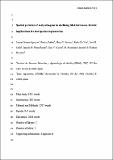Por favor, use este identificador para citar o enlazar a este item:
http://hdl.handle.net/10261/47723COMPARTIR / EXPORTAR:
 SHARE SHARE
 CORE
BASE CORE
BASE
|
|
| Visualizar otros formatos: MARC | Dublin Core | RDF | ORE | MODS | METS | DIDL | DATACITE | |

| Título: | Spatial patterns of soil pathogens in declining Mediterranean forests: implications for tree species regeneration |
Autor: | Gómez Aparicio, Lorena CSIC ORCID ; Ibáñez Moreno, Beatriz CSIC; Serrano, María S. CSIC ORCID CVN; De Vita, Paolo; Ávila Castuera, José M. CSIC ORCID; Pérez-Ramos, Ignacio Manuel CSIC ORCID; García, Luis V. CSIC ORCID ; Sánchez, María Esperanza; Marañón, Teodoro CSIC ORCID | Palabras clave: | Forest decline Neighborhood models Quercus suber Regeneration dynamics Soil-borne pathogens Soil texture Species coexistence |
Fecha de publicación: | jun-2012 | Editor: | Wiley-Blackwell | Citación: | New Phytologist 194 (4): 1014-1024 (2012) | Resumen: | Soil-borne pathogens are a key component of the belowground community because of the significance of their ecological and socio-economic impacts. However, very little is known about the complexity of their distribution patterns in natural systems. Here, we explored the patterns, causes and ecological consequences of spatial variability in pathogen abundance in Mediterranean forests affected by oak decline. • We used spatially explicit neighborhood models to predict the abundance of soil-borne pathogen species (Phytophthora cinnamomi, Pythium spiculum and Pythium spp.) as a function of local abiotic conditions (soil texture) and the characteristics of the tree and shrub neighborhoods (species composition, size and health status). The implications of pathogen abundance for tree seedling performance were explored by conducting a sowing experiment in the same locations in which pathogen abundance was quantified. • Pathogen abundance in the forest soil was not randomly distributed, but exhibited spatially predictable patterns influenced by both abiotic and, particularly, biotic factors (tree and shrub species). Pathogen abundance reduced seedling emergence and survival, but not in all sites or tree species. • Our findings suggest that heterogeneous spatial patterns of pathogen abundance at fine spatial scale can be important for the dynamics and restoration of declining Mediterranean forests. | Descripción: | 11 pages, 5 figures, 2 tables, 66 references. | Versión del editor: | http://dx.doi.org/10.1111/j.1469-8137.2012.04108.x | URI: | http://hdl.handle.net/10261/47723 | DOI: | 10.1111/j.1469-8137.2012.04108.x | ISSN: | 0028-646X | E-ISSN: | 1469-8137 |
| Aparece en las colecciones: | (IRNAS) Artículos |
Ficheros en este ítem:
| Fichero | Descripción | Tamaño | Formato | |
|---|---|---|---|---|
| Spatial patterns of soil pathogens in declining Mediterranean forests.pdf | 342,79 kB | Adobe PDF |  Visualizar/Abrir |
CORE Recommender
SCOPUSTM
Citations
89
checked on 22-abr-2024
WEB OF SCIENCETM
Citations
83
checked on 22-feb-2024
Page view(s)
311
checked on 24-abr-2024
Download(s)
261
checked on 24-abr-2024
Google ScholarTM
Check
Altmetric
Altmetric
NOTA: Los ítems de Digital.CSIC están protegidos por copyright, con todos los derechos reservados, a menos que se indique lo contrario.
